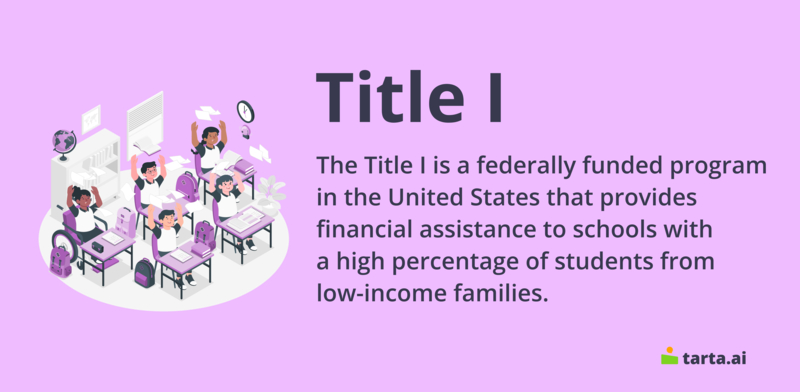The Title I Program: Ensuring Educational Opportunities for Disadvantaged Students

The program is part of the Elementary and Secondary Education Act (ESEA), which was first passed in 1965 as part of President Lyndon B. Johnson's War on Poverty.
Goals of the program
The goal of the Title I program is to provide additional resources and support to disadvantaged students to help them succeed academically.
The program provides funding to schools with high percentages of low-income students, which can be used to supplement, not supplant, the regular education program of the school. This funding can be used to provide additional instructional materials, tutoring services, after-school programs, and professional development for teachers.
In addition to providing additional resources and support to disadvantaged students, the Title I program also aims to reduce the achievement gap between disadvantaged students and their peers. Research has shown that schools that receive Title I funding are more likely to make gains in student achievement than schools that do not receive funding.
Eligibility requirements for Title I funding
To be eligible for Title I funding, a school must have a high percentage of students from low-income families, typically defined as those who qualify for free or reduced-price lunch programs. The percentage of low-income students required to qualify for Title I funding varies depending on the state and school district.
The funds are allocated based on the number of eligible students in a school or district, with schools with higher percentages of low-income students receiving more funding.
Schools that receive Title I funding are required to develop a comprehensive plan for how they will use the funds to improve the academic achievement of their disadvantaged students. This plan must be based on the school's needs and must include specific goals and objectives for improving student achievement.
In addition to eligibility requirements based on the percentage of low-income students, schools must also meet other requirements to receive Title I funding. For example, schools must have qualified teachers and meet state and federal academic standards. Schools must also provide appropriate services to students with disabilities and English language learners.

Photo: Kenny Aliason/ Unsplash
Parts of the Title I Program
The program has several parts that work together to provide support and resources to disadvantaged students. Here is a brief overview of each part:
Part A: Targeted Assistance
Part A of the Title I program provides funding to schools with a high percentage of low-income students to implement targeted assistance programs. These programs are designed to provide additional academic support and resources to students who are most in need. Schools use Title I funds to provide tutoring, after-school programs, professional development for teachers, and instructional materials to help students succeed academically.
Part B: Schoolwide Programs
Part B of the Title I program allows schools with a poverty rate of at least 40% to implement schoolwide programs. These programs are designed to improve the overall educational experience for all students in the school, not just those who are considered to be disadvantaged. Schools with schoolwide programs use Title I funds to implement a comprehensive plan that addresses the academic needs of all students.
Part C: Education of Migratory Children
Part C of the Title I program provides funding to states and local educational agencies to support the education of migratory children. This includes children who have moved across state lines within the past three years in order to work in agriculture or fishing.
Part D: Prevention and Intervention Programs for Children and Youth who are Neglected, Delinquent, or At-Risk
Part D of the Title I program provides funding to support the education of children and youth who are neglected, delinquent, or at-risk. This includes children who are in correctional facilities, foster care, or homeless.
Part E: Flexibility for Equitable Per-Pupil Funding
Part E of the Title I program provides funding to states and local educational agencies to support equitable per-pupil funding. This funding is intended to provide greater flexibility for schools to meet the needs of disadvantaged students.
Part F: General Provisions
Part F of the Title I program contains general provisions related to the program, including definitions, authorization of appropriations, and reporting requirements.
Benefits of the Title I Program
There are several key benefits of the Title I program:
- Provides additional resources and support for disadvantaged students: The primary objective of the Title I program is to provide additional academic support and resources to disadvantaged students, including those from low-income families, to help them succeed academically. This can include additional instructional materials, tutoring services, after-school programs, and professional development for teachers.
- Reduces the achievement gap: The program helps to reduce the achievement gap between disadvantaged students and their peers by providing additional resources and support. Research has shown that schools that receive Title I funding are more likely to make gains in student achievement than schools that do not receive funding.
- Provides resources to schools that would otherwise be unable to afford them: Many low-income schools lack the resources to provide the same level of education as their more affluent counterparts. The Title I program helps to level the playing field by providing additional resources and support to these schools.
- Increases parent involvement: The Title I program requires schools to involve parents in the development of their Title I plan and in decision-making related to the use of Title I funds. This helps to increase parent involvement in their children's education and can lead to improved academic outcomes.
- Supports professional development for teachers: The Title I program provides funding for professional development for teachers, which can help to improve their instructional skills and knowledge. This can lead to improved student achievement and a higher quality of education for all students.
The Title I program has also been shown to have a positive impact on student achievement. According to the National Assessment of Educational Progress (NAEP), low-income students who attended Title I schools scored higher on reading and math tests than those who attended non-Title I schools. In addition, a study by the U.S. Department of Education found that schools that received Title I funds were more likely to make gains in student achievement than schools that did not receive Title I funds.
In conclusion, the Title I program is an essential component of the U.S. education system that provides critical support and resources to low-income schools and students. By providing additional academic support, reducing the achievement gap, and helping students succeed academically, the program helps to ensure that all children have access to a high-quality education that will prepare them for success in college and career.
- The Title I program is a federal program that provides additional resources and support to disadvantaged students in order to help them succeed academically.
- The program has several parts that work together to provide support and resources to disadvantaged students, including Targeted Assistance, Schoolwide Programs, Education of Migratory Children, Prevention and Intervention Programs for Children and Youth who are Neglected, Delinquent, or At-Risk, Flexibility for Equitable Per-Pupil Funding, and General Provisions.
- Schools that receive Title I funding are required to develop a comprehensive plan for how they will use the funds to improve the academic achievement of their disadvantaged students.
- The benefits of the Title I program include providing additional resources and support for disadvantaged students, reducing the achievement gap, providing resources to schools that would otherwise be unable to afford them, increasing parent involvement, and supporting professional development for teachers.
FAQ
What is the Title I program?
The Title I program is a federally funded program that provides financial assistance to schools with a high percentage of low-income students.
How are schools selected to participate in the Title I program?
Schools are selected to participate in the Title I program based on their percentage of low-income students. The program provides funding to schools where at least 40 percent of students come from low-income families.
What types of services are provided through the Title I program?
The Title I program provides a variety of services to support student learning, such as extra instructional time, tutoring, professional development for teachers, and the purchase of instructional materials and technology.
Can private schools participate in the Title I program?
Yes, private schools can participate in the Title I program, but they must meet certain requirements, such as providing equitable services to eligible students and ensuring that services are secular, neutral, and non-ideological.
How is the success of the Title I program measured?
The success of the Title I program is measured through various means, such as student achievement data, school performance indicators, and program evaluations. Schools that receive Title I funding are required to report on their progress and the effectiveness of the services they provide.